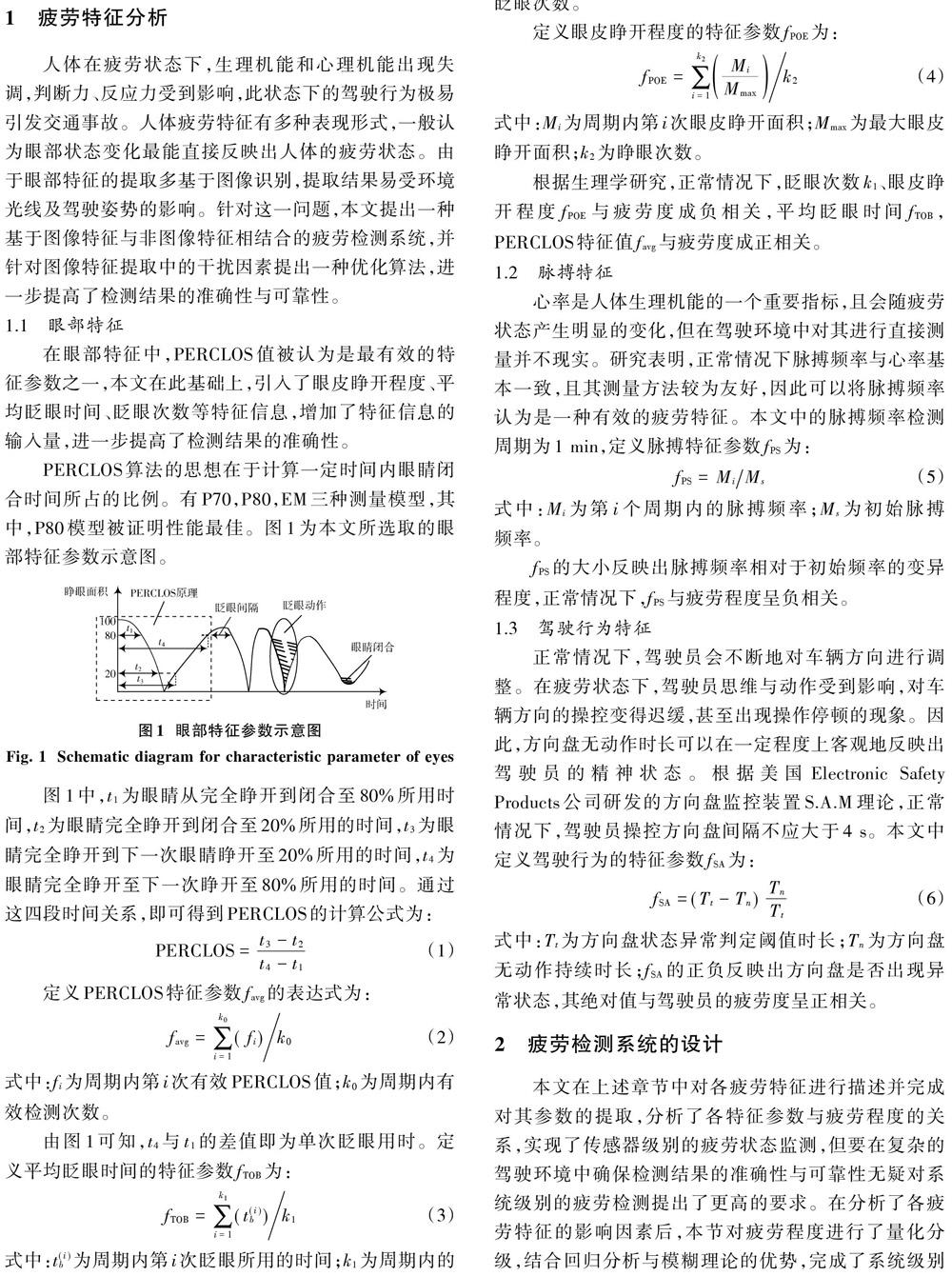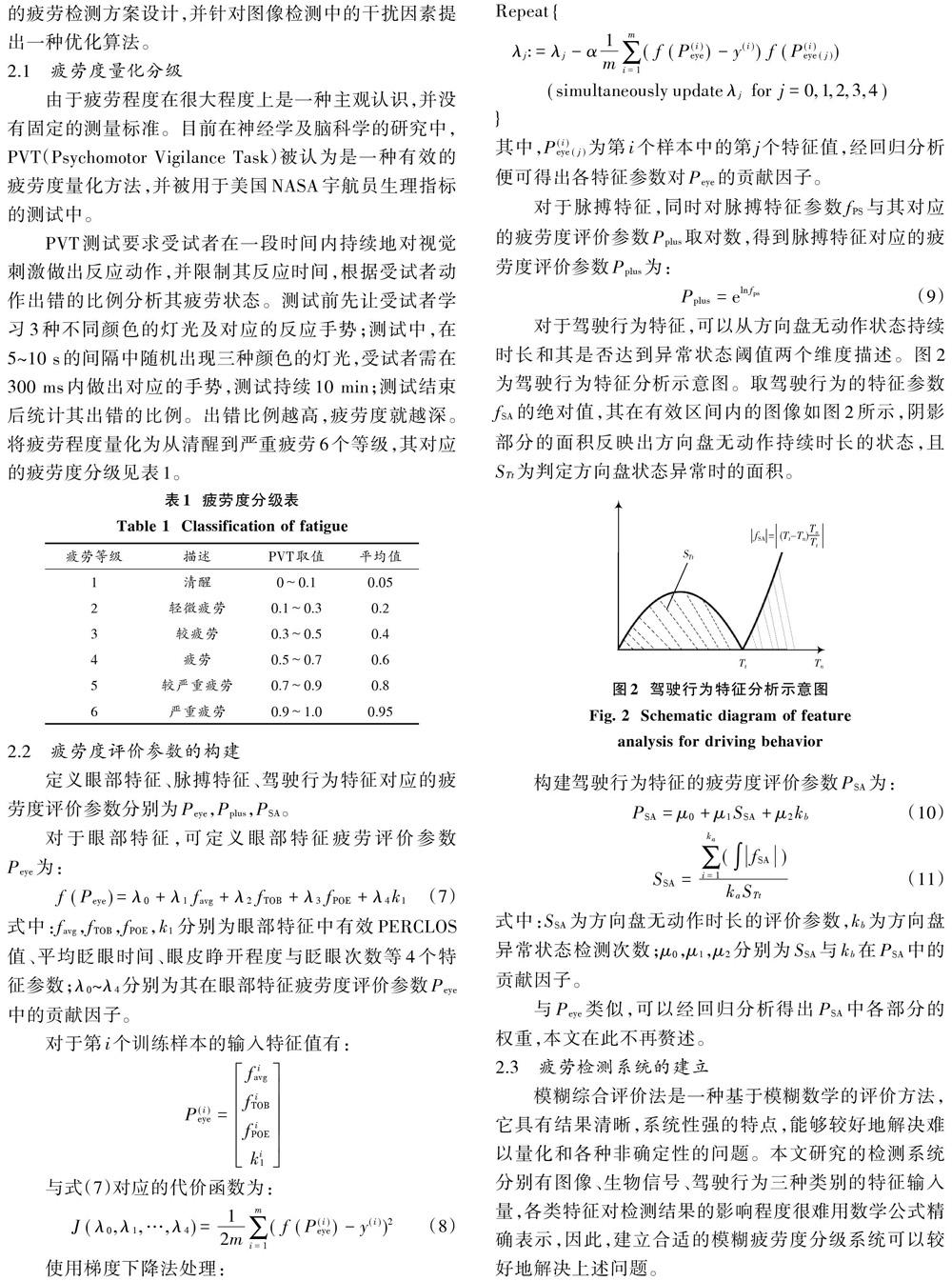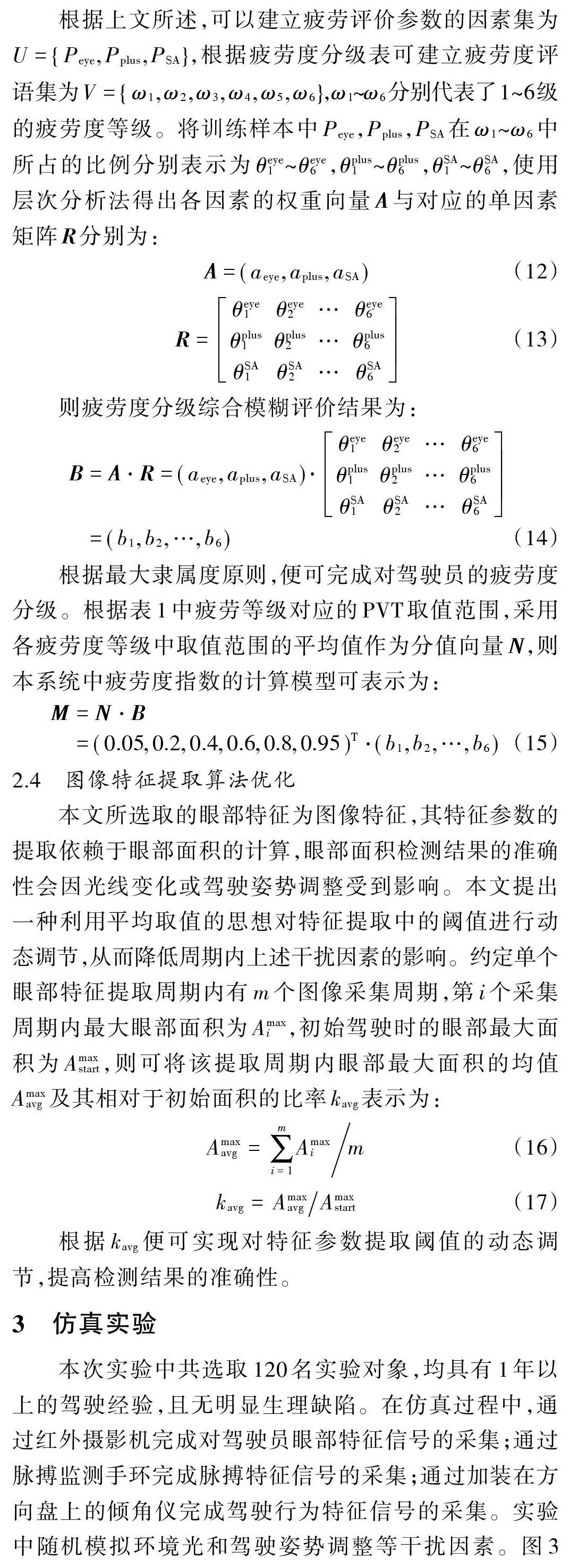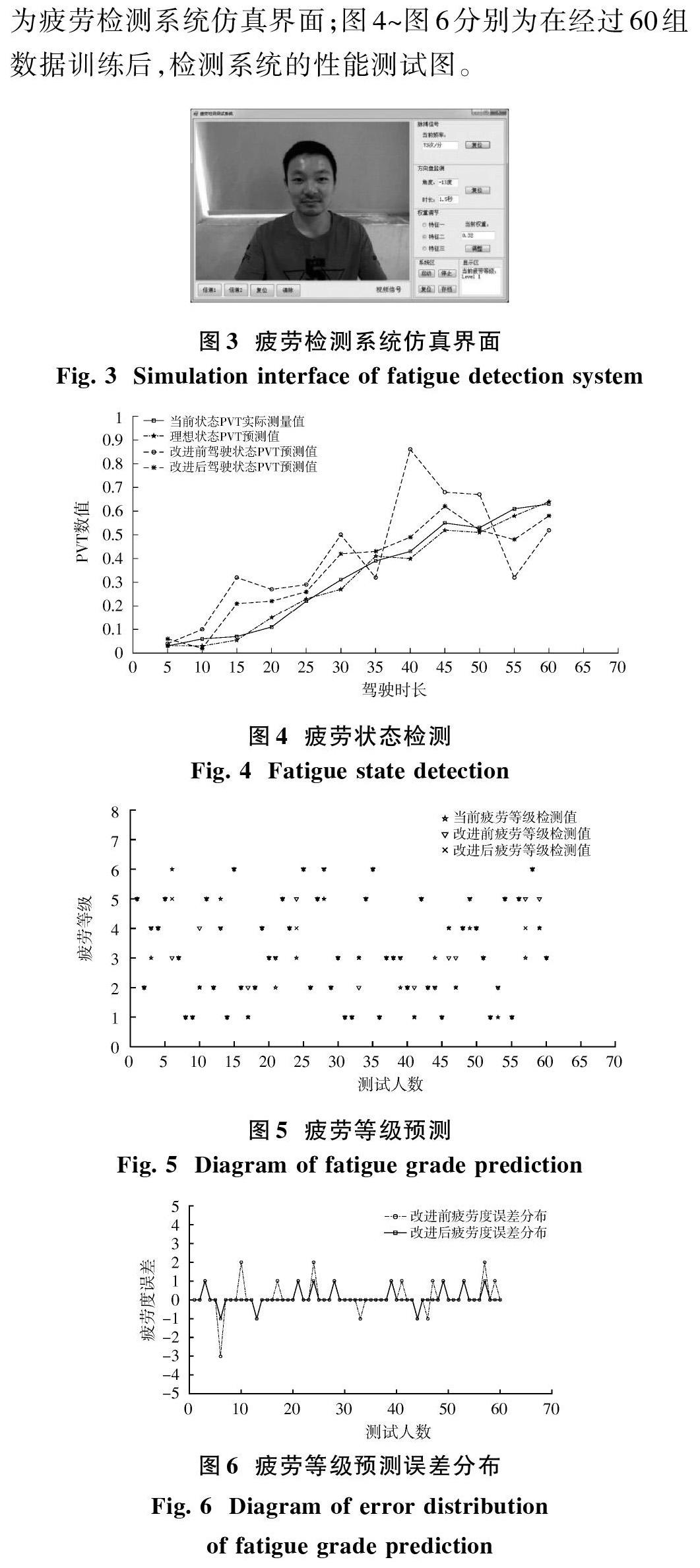基于多类别特征融合的疲劳检测系统研究
2019-01-10张博李鸿李会超
张博 李鸿 李会超
关键词: 疲劳检测; 信息融合; 图像识别; 行为特征; 回归分析; 模糊评价
中图分类号: TN911.73?34; TP391 文献标识码: A 文章编号: 1004?373X(2019)01?0152?05
Abstract: The single or similar feature index in fatigue detection is easily disturbed, so a fatigue detection system based on multi?class feature information fusion is proposed according to the regression analysis and fuzzy evaluation theory. In accordance with the features of each fatigue characteristic, the feature parameters are described and extracted. The quantitative classification of fatigue degree is performed in combination with PVT test. The advantages of regression analysis for explaining the multivariate influence intensity and fuzzy mathematics for dealing with the uncertain problems are used to complete the design and modeling of the detection system. An optimization algorithm is proposed to overcome the interference factors in image feature extraction. The simulation experimental results show this system can detect the fatigue state of drivers effectively, and its performance is obviously improved by the optimization algorithm.
Keywords: fatigue detection; information integration; image identification; behavioral characteristic; regression analysis; fuzzy evaluation
0 引 言
随着交通运输业的迅猛发展,机动车数量急剧增加,其造成的交通事故也不断增多。据世界卫生组织2015年的报告,全世界每年约有125万人死于交通事故,造成的经济损失非常巨大。研究表明,60%左右的重大交通事故与疲劳驾驶有关[1]。因此,对疲劳驾驶检测的研究有着非常重要的理论和现实意义。
目前,针对疲劳检测这一问题主要有基于生理参数和基于行为特征两类检测方法。如日本Canon KK基于脑电波这一生理参数,研发了一种防瞌睡装置。文献[2]以驾驶员对方向盘的操作行为作为突破口,设计了基于ZigBee的车载疲劳检测方案,在不降低识别率的前提下实现了驾驶员疲劳状态的快捷检测。但此类检测方案多采用单一的检测指标,检测结果的可靠性会因环境干扰而明显降低。由Seeing Machines公司研发的Face LAB系统[3]则是检测驾驶员瞳孔直径、头部姿态、凝视方向等多个特征信息,并进行融合分析,进一步增强了检测结果的准确性。但因其所选特征均为图像特征,所受干扰因素相同,检测结果的可靠性并没有得到明显改善。文献[4]在图像信息检测的基础上,引入车辆轨迹分析,并采用SVM算法的数据融合模型,在一定程度上降低了图像特征提取中干扰因素对检测结果的影响,但车辆轨迹分析本身受路况等复杂环境影响较大,可靠性存疑。本文在融合信息检测理念的基础上,选取不同类别的疲劳特征,完成了疲勞度的量化分级,结合回归分析及模糊评价理论的优势,设计了一套基于多类别特征的疲劳检测系统,有效地提高了检测结果的可靠性和准确性。




图4为实验中随机挑选的一名实验对象的检测数据,从图4可以看出系统可以有效地反映出疲劳度与驾驶时长的关系,且经算法改进后的预测值与测量值更为接近,波动范围明显变小。图5,图6可反映出针对图像特征提取中干扰因素的优化算法对系统性能提升明显。约定系统性能的评价标准为预测误差百分比,平均绝对误差MAE,均方根误差RMSE,可得到系统性能评价如表2所示。由表2可知,改进前后的系统预测误差分别为26%和19%,且改进后MAE与RMSE的降幅分别为52%与43%,预测结果的准确性和稳定性明显增加。由此可见,本文建立的系统可以有效地完成对驾驶员疲劳状态的检测,针对图像特征提取中干扰因素的优化算法对系统性能提升明显。

4 结 语
本文通过提取不同类别的疲劳特征信息,克服了单一指标或同类信息融合指标在疲劳检测中易受干扰这一不足。结合PVT测试完成驾驶员疲劳状态的量化分级,综合回归分析与模糊评价理论各自的优势,完成了系统级别的疲劳状态检测方案的设计与建模,针对图像特征提取中的干扰因素提出一种优化算法。通过仿真实验检验了系统性能及优化算法的有效性。
参考文献
[1] 孙伟,张为公,张小瑞,等.疲劳驾驶检测方法的研究进展[J].汽车技术,2009(2):1?5.
SUN Wei, ZHANG Weigong, ZHANG Xiaorui, et al. Development of fatigue driving detection method research [J]. Automobile technology, 2009(2): 1?5.
[2] 聂尔豪,苏维均,于重重,等.车载疲劳驾驶行为检测系统的研究与设计[J].计算机仿真,2013,30(8):173?176.
NIE Erhao, SU Weijun, YU Chongchong, et al. Research and design of fatigue driving behavior system in vehicle [J]. Computer simulation, 2013, 30(8): 173?176.
[3] ZHENG X L, LI X S, CHENG Z Q, et al. Analysis of driver visual characteristics based on FaceLAB [J]. Applied mecha?nics and materials, 2014, 526: 283?287.
[4] 李娟,王富,王维锋,等.基于数据融合的疲劳驾驶检测算法[J].武汉工程大学学报,2016,38(5):505?510.
LI Juan, WANG Fu, WANG Weifeng, et al. Research on dangerous driving behavior recognition and vehicle tracking algorithm based on data fusion [J]. Journal of Wuhan Institute of Technology, 2016, 38(5): 505?510.
[5] 谢承玲,陈彩明,刘堂宇.一种车载疲劳驾驶监测仪[J].现代电子技术,2013,36(12):121?123.
XIE Chengling, CHEN Caiming, LIU Tangyu. A vehicle?mounted fatigue driving monitor [J]. Modern electronics technique, 2013, 36(12): 121?123.
[6] 李俊峰.基于OPENCV的人眼检测算法研究[J].科技经济导刊,2017(24):37.
LI Junfeng. Research on eye detection based on OPENCV [J]. Technology and economic guide, 2017(24): 37.
[7] 李春杰,王春,王全虎.基于嵌入式平台人眼疲劳检测终端的设计与实现[J].现代电子技术,2016,39(24):6?8.
LI Chunjie, WANG Chun, WANG Quanhu. Design and implementation of human eye fatigue detection terminal based on embedded platform [J]. Modern electronics technique, 2016, 39(24): 6?8.
[8] 胡玉峰.基于OpenCV的嵌入式人眼追踪系统研究[J].电子科技,2014,27(9):58?61.
HU Yufeng. Research on embedded eye tracking system based on OpenCV [J]. Electronic science and technology, 2014, 27(9): 58?61.
[9] 邹昕彤.基于表情与头部状态识别的疲劳驾驶检测算法的研究[D].长春:吉林大学,2017.
ZOU Xintong. Research on fatigue driving detection algorithm based on expression and head state recognition [D]. Chang?chun: Jilin University, 2017.
[10] SOMMER D, GOLZ M. Evaluation of PERCL?OS based current fatigue monitoring technologies [C]// 2010 Annual International Conference of the IEEE Engineering in Medicine and Biology. Buenos Aires: IEEE, 2010: 4456.
